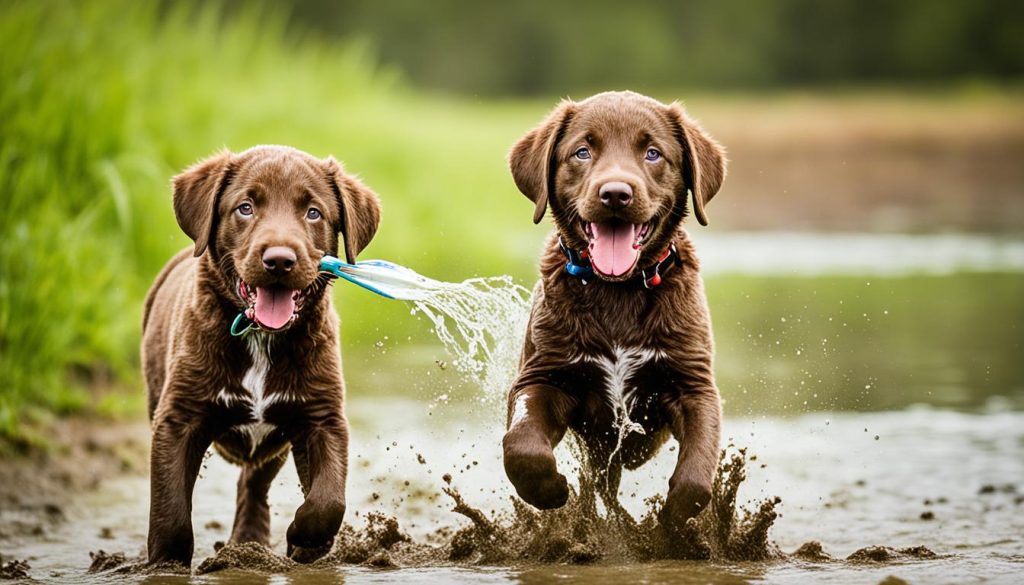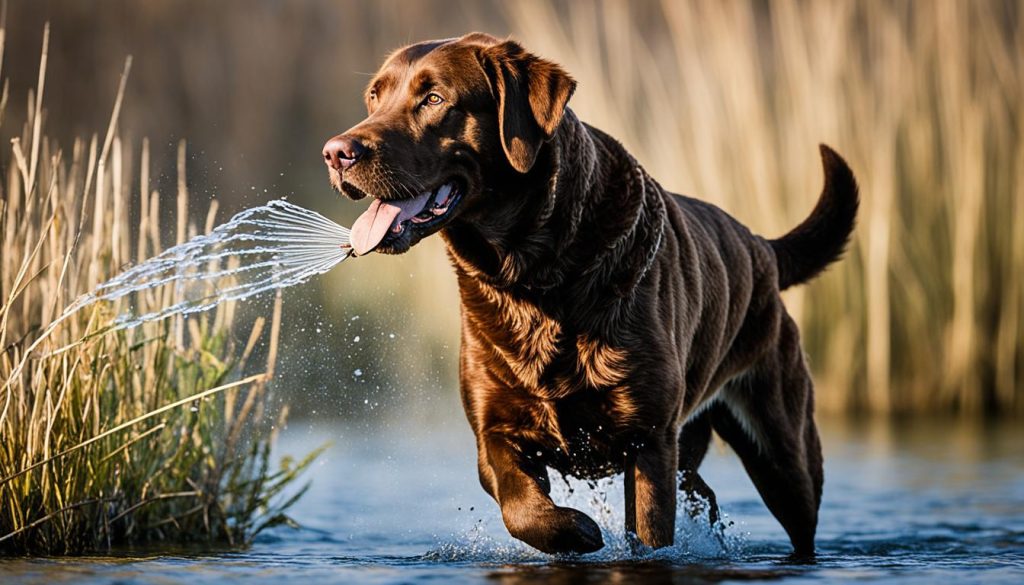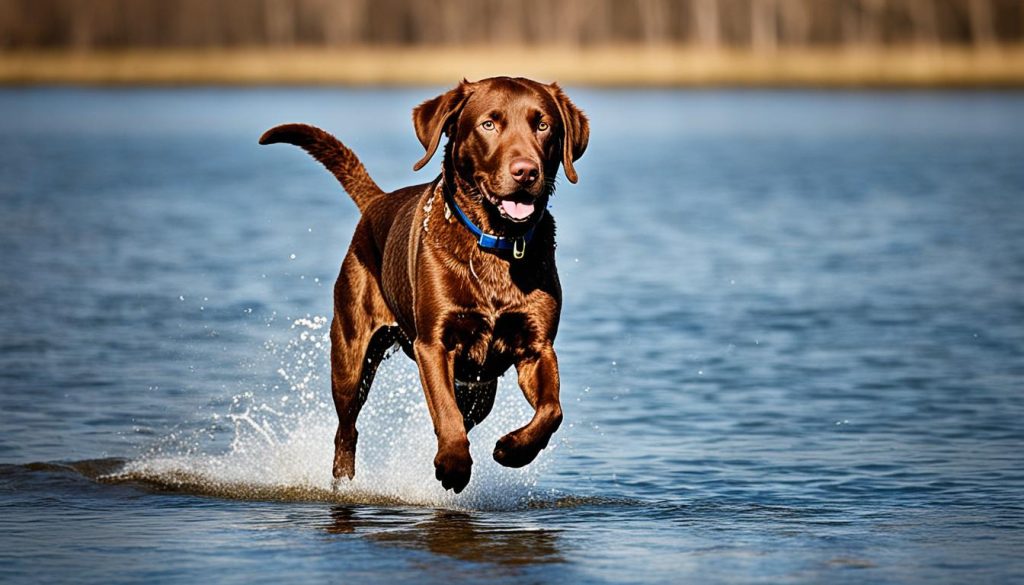Forged by the formidable tides of the Atlantic, the Chesapeake Bay Retriever exemplifies resilience, endurance, and unwavering loyalty. This breed combines a muscular build with a friendly personality and keen intelligence. It has garnered an illustrious reputation since its origins in Maryland, USA. Renowned for unmatched waterfowl retrieval abilities, its temperament is affectionate toward its kin, yet it stands guard with a protective zeal when necessitated. Prospective owners need to delve deeply into the breed’s characteristics and care needs before seeking Chesapeake Bay Retriever for sale listings.
Key Takeaways
- Sturdy build and adaptability makes the Chesapeake Bay Retriever a robust companion.
- The breed’s loyal temperament fosters a strong bond with family members.
- Chesapeake Bay Retrievers are diligently focused, reflecting their history as skilled retrievers.
- Awareness of breed-specific care needs is crucial for prospective Chesapeake Bay Retriever owners.
- Considering a Chesapeake Bay Retriever for sale entails a rigorous evaluation of the breed’s traits and suitable environment.
Understanding the Chesapeake Bay Retriever Breed
The exploration of the Chesapeake Bay Retriever’s history reveals a saga of resilience and robustness, necessary for waterfowl hunting in the challenging conditions of the Chesapeake Bay. These canines are lauded for their unparalleled work ethic, evolving from skilled retrievers to cherished family members worldwide. Individuals drawn to the breed’s distinct allure might consider acquiring Chesapeake Bay Retriever puppies or the advantages of adopting from a Chesapeake Bay Retriever rescue. It is crucial, however, to comprehend the responsibilities entailed in owning such a breed, for both novice and seasoned dog owners.

To integrate a Chesapeake Bay Retriever into your life, one must identify reputable Chesapeake Bay Retriever breeders. These breeders are committed to the health, temperament, and overall welfare of their dogs, laying a solid foundation for the puppies. For individuals moved by the idea of offering a second chance to a dog in need, exploring a Chesapeake Bay Retriever rescue presents a gratifying choice. Such establishments often have a range of dogs, from adults to puppies, each with a distinct narrative and character.
Choosing a Chesapeake Bay Retriever through either an esteemed breeder or rescue institution forms the basis for a nurturing and lasting bond between pet and owner, leading to enriching companionship.
Introducing Chesapeake Bay Retriever puppies into your abode necessitates preparation and insight. These vivacious puppies prosper in spaces that offer freedom for exploration, alongside an owner committed to their comprehensive engagement. Their astuteness and attentiveness render them quick learners, yet they yearn for unwavering guidance and systematic training to grow into well-adjusted mature dogs.
- Research: Start by investigating the breed’s unique characteristics and care requirements.
- Visit: Get to know breeders or rescue organisations to observe their practices and meet the dogs.
- Plan: Ensure your lifestyle can accommodate the energy levels and space needs of this sizeable breed.
- Prepare: Equip your home with all the essentials before bringing your new companion home.
The table below outlines critical aspects to consider when bringing a Chesapeake Bay Retriever into your life, whether through a breeder or rescue:
| Consideration | From Breeders | From Rescue |
|---|---|---|
| Health Certifications | Breeders typically provide health clearances for puppies. | Variable; rescues may have limited health histories. |
| Age Range | Puppies are usually available at 8-12 weeks old. | Includes all ages; puppies to senior dogs. |
| Temperament | Breeders can often provide insights into a puppy’s expected temperament. | Rescue organisations assess temperament to match dogs with suitable homes. |
| Training Requirements | Intensive initial training required for puppies. | May vary; some rescue dogs come with basic training, while others need more attention. |
| Long-term Commitment | Understanding and commitment to breed-specific needs are essential. | Patience and dedication to helping a rescue dog adjust to a new home. |
In summary, acquiring a Chesapeake Bay Retriever, through breeders or adoption, mandates a deep commitment and a thorough understanding of the breed’s nuances. Whether one is drawn to the energy of young Chesapeake Bay Retriever puppies or the devoted affection of a rescue, the breed epitomises loyalty, bravery, and steadfastness. These traits deeply resonate with enthusiasts of these remarkable canines.
Essential Care Tips for Chesapeake Bay Retriever Owners
The Chesapeake Bay Retriever stands out, owing to its resemblance and historical ties to the Labrador. It demands specific care and attention from its owners. This section aims to provide vital insights into their care, covering dietary needs, exercise, grooming, and health. Proper training is crucial for their physical and mental health.
Feeding and Nutrition
Comparing the Chesapeake Bay Retriever and Labrador reveals unique dietary needs. The Chesapeake’s active lifestyle calls for a diet rich in proteins, fats, and carbohydrates. Considering their energy levels, a customized diet helps prevent obesity. A structured feeding routine, along with effective training, prevents overeating and ensures optimal health.
Exercise Requirements
Chesapeake Bay Retrievers need significant exercise to manage their energy. Established exercise routines help control their exuberance and curb mischievous tendencies. Engaging in high-intensity activities and regular training stimulates their minds and prevents boredom or destructive behavior. A minimum of 4 hours of vigorous activity per week is advised for their well-being.
Regular Grooming Practices
Grooming is crucial for Chesapeake Bay Retrievers, especially because of their dense, waterproof coats. Regular grooming aids in managing shedding and skin health. Routine brushing, done at least three times a week, and occasional baths are necessary to keep them clean. New owners should be aware of these grooming needs from the puppy stage.
Health Screenings and Veterinary Care
Chesapeake Bay Retrievers require vigilant health screenings, similar to Labradors. It is essential to select breeders who provide comprehensive health clearances. Preventative care, including regular check-ups and vaccinations, is crucial for their health. Aligning with a rescue organization could also provide valuable medical care resources and advice.

| Chesapeake Bay Retriever | Labrador |
|---|---|
| Enjoys high intensity and diverse activities | Prefers moderate to high exercise routines |
| Preferential for streamlined, high-protein diets | Can adapt to a broader range of diets |
| Needs thorough grooming due to dense coat | Requires regular grooming with less intensity |
| Requires firm, consistent training methods | Responsive to a variety of training approaches |
Training and Socialising Your Chesapeake Bay Retriever
Characterised by intelligence and determination, the Chesapeake Bay Retriever thrives on careful training and steadfast socialisation. Recognising their distinct character and inherent skills allows owners to develop a compliant and versatile pet. This section outlines effective methods for enhancing obedience, promoting positive behaviour, and integrating the dog’s natural retriever instincts into their overall character.
Basic Obedience Training
Basic obedience training sets the stage for a balanced owner-dog relationship. It’s optimal to begin training Chesapeake Bay Retrievers at about 5 months, during their most absorbent learning phase. Concentrating on commands like sit, stay, and come regulates their enthusiasm and boldness. Frequent training boosts mental engagement and bolsters the dog’s inherent eagerness to learn and satisfy their owner, fundamental to their temperament.
Socialisation Strategies
Effectual socialisation is vital for cultivating a well-rounded Chesapeake Bay Retriever. Introducing them early to various settings, people, and fellow animals mitigates the risk of undue shyness or aggressive tendencies. Successful socialisation tactics entail gradual exposure to novel experiences, coupled with a supportive, affirmative approach to foster self-assurance. Underlining this facet of growth is especially critical for those exploring Chesapeake Bay Retrievers in domestic or occupational roles.
Addressing Retrieving Instincts
Utilizing the breed’s intrinsic retrieving impulses enhances varied and captivating training. Engaging them in activities that mirror their ancestral duties, like retrieval and carry exercises, allows them to expend energy constructively. Comparatively, the Chesapeake Bay Retriever and Labrador both show proficiency in retrieval-based tasks, yet Chesapeakes, exhibiting greater determination, might necessitate more decisive training methods.
| Training Aspect | Chesapeake Bay Retriever Training Benefit | Labrador Training Benefit |
|---|---|---|
| Reliability of response to commands | Increased control over strong-willed tendencies | Enhanced cooperation and owning experience |
| Social adaptability | Reduced environmental sensitivity, better integration | More approachable and interactive with humans and pets |
| Use of natural instincts | Productive outlet for energy, enhanced mental well-being | Engagement and fulfilment of breed-specific traits |
Adherence to ongoing, systematic training sessions with your Chesapeake Bay Retriever is vital. It is essential for amending any difficult aspects of their character, solidifying enduring behaviour patterns, and unlocking the breed’s immense capacity for loyalty and strength.
Conclusion
As we conclude our discussion on the Chesapeake Bay Retriever, it’s evident that the breed’s robustness extends beyond its physical form to its loyalty and capabilities. The journey to becoming a responsible Chesapeake Bay Retriever owner involves a comprehensive understanding of the breed. This includes recognizing their unique characteristics and the attention they demand. We’ve deduced that proper training and socialisation aren’t merely suggested but are pivotal in unlocking the breed’s remarkable potential and personality.
For potential owners, choosing between reputable breeders or rescue organisations presents two beneficial paths. Breeders can provide valuable insight into the dog’s lineage and preliminary training. Meanwhile, adopting from a rescue offers a chance to provide a loving home to a dog in need. Both options necessitate a profound commitment to responsible pet ownership. This ensures the dog is enshrouded in love, attention, and the necessary structure for its wellbeing.
Ultimately, the Chesapeake Bay Retriever exemplifies the profound joy and fulfilment inherent in the dog-human bond. They symbolise the heights of what can be achieved through informed care, diligent training, and unwavering affection. Potential owners are thus encouraged by the plethora of available information. They can be reassured that their dedication to these canines will be rewarded abundantly through their companionship and service.
FAQ
What are the defining characteristics of a Chesapeake Bay Retriever?
The Chesapeake Bay Retriever is distinguished by its robust structure, a dense, waterproof pelage, and luminous, perspicacious eyes. This breed showcases a courageous, amiable, and loyal disposition. Originating as a waterfowl retriever, it exemplifies exceptional vigour and stamina.
Where can one find Chesapeake Bay Retriever puppies for sale?
Chestnut Bay Retriever puppies are procurable through accredited breeders, specific online marketplaces, and breed associations offering breeder recommendations. Endeavour to undertake extensive research to ascertain the breeder adheres to ethical breeding standards.
How should one approach the training of a Chesapeake Bay Retriever?
Training for a Chesapeake Bay Retriever necessitates consistency, patience, and adaptation to their sapient yet sometimes obstinate nature. Incorporate basic obedience, socialisation, and leverage their intrinsic retrieving instincts. Commencing training early and persistently is vital for their development.
What are the exercise needs of a Chesapeake Bay Retriever?
Chesapeake Bay Retrievers demand significant, regular activity to sustain their physical and mental health. Optimal activities include extended ambles, swimming, and retrieval exercises, catering to their energetic disposition and instinctual requirements.
Are Chesapeake Bay Retrievers suitable for families?
Indeed, the Chesapeake Bay Retriever can integrate well into family settings. Characterised by loyalty and a protective inclination, it is crucial to commence socialisation and training promptly to assure they adapt to children and other animals seamlessly.
How do Chesapeake Bay Retrievers compare to Labrador Retrievers?
While Chesapeake Bay Retrievers and Labrador Retrievers both excel in retrieval and harbour a fondness for aquatic environments, they diverge in temperament and fur characteristics. Chesapeake Bay Retrievers exhibit a more guarded demeanour towards strangers and possess a dense, oily, water-resistant coat, contrasting with the Labrador’s sleeker, shorter fur. Regarding training and vigour, both breeds thrive on continual, intellectually enriching exercises.
What grooming practices are recommended for Chesapeake Bay Retrievers?
Chesapeake Bay Retrievers benefit from routine grooming, which includes brushings multiple times weekly to mitigate shedding and avert tangling. It’s also advisable to clean their auricles to forestall infections, trim their claws, and cleanse their teeth. Their water-repellent fur necessitates sporadic washing with canine-formulated cleansers.
How can Chesapeake Bay Retriever rescues support the breed?
Rescue organisations for Chesapeake Bay Retrievers assist by facilitating the rehoming of abandoned or relinquished canines. They frequently proffer medical attention, rehabilitation, and foster care, ensuring the dogs’ health and sociability prior to adoption. Moreover, they are a critical resource for potential owners to acquaint themselves with the breed and identify a compatible companion.
What kind of diet is best for a Chesapeake Bay Retriever?
A diet that is harmonised with their age, level of activity, and particular health requirements is imperative for Chesapeake Bay Retrievers. A high-calibre commercial dog feed or a veterinary-endorsed home-cooked regimen, replete with proteins and fatty acids, is beneficial for sustaining their dynamism and fur health.
Where can I find a reputable Chesapeake Bay Retriever breeder?
Locating a reputable Chesapeake Bay Retriever breeder is feasible through national breed societies, canine registries, and recommendations from veterinarians or breed enthusiasts. It is critical to inspect the breeding premises, engage with the breeder, view the puppies in their surroundings, and seek health certifications for the progenitors.

